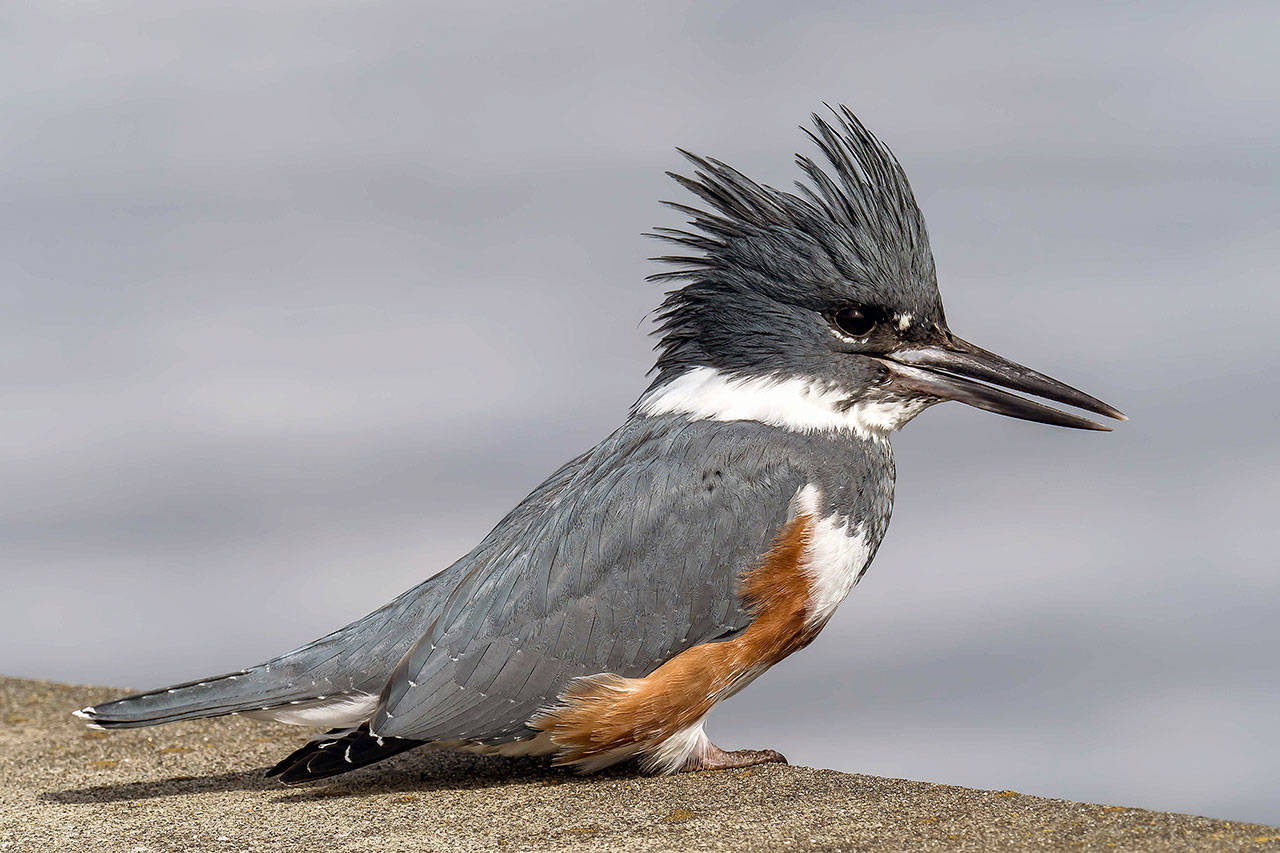By Dianna Moore
Grays Harbor Audubon
I finally got the right photo to showcase this wonderful bird, a female kingfisher. They are very active, so it had to be in good focus and the right size to show off her plumage. Thanks to Gregg Thompson, we have all that. As I drive to and from various locations, I am constantly watching for birds along the route and kingfishers are pretty easy to spot, and common to our area year-round. I am always pleased to see one hanging out on a power line, intently watching for prey in a stream below.
General Description: Belted Kingfishers are short and stocky with large heads, a ragged crest, a large straight bill, and short legs. Their overall colors are a slate blue back, a white belly with a slate blue belly band, a white collar, and a white spot in front of each eye. The female also has a rufous-colored belly band that extends to patches on her sides. They are 11 to 13.8 inches long, with a wingspan of 19 to 23 inches, and weigh approximately five to six ounces.
Habitat: Kingfishers can be found along either fresh or salt water shorelines and wetlands. They need access to sandy banks to dig out their burrows and prefer it be over the water to minimize problems with predators. They also need clear water so they can see their prey from above.
Behavior: As a bird that hunts prey from a perch, kingfishers may hover over water until they spot something, then dive headfirst to capture their prey. They also spend a lot of time just perched and waiting for prey to appear. They are relatively easy to find, thanks to their active hunting behavior and their loud, rattling call. They are also very territorial and will vigorously defend their territories.
Diet: Belted Kingfishers eat a lot of small fish, but they will also take crayfish, other crustaceans, frogs and tadpoles, aquatic insects, and even berries. Young birds digest bones and scales but the older birds cough up pellets of the fish bones and invertebrate shells.
Nesting: Both male and female birds excavate a burrow three to six feet into a soft bank, sloped upward to prevent rainwater accumulating. There is a chamber at the top of the burrow which accumulates bones and other leftovers for extra insulation. The unlined chamber is eight to 12 inches in diameter and six to seven inches high. Both the female and male incubate five to seven eggs for 22 to 24 days. Both parents regurgitate fish to feed their young.
Migration: Washington state birds seldom migrate, thanks to plentiful open water. For those who migrate out of the state, they may travel as far south as northern South America. Most migrants in Washington move from higher elevations down to the lower elevations as winter moves in. We also find migrants arriving from farther north to spend their winter here.
Conservation Status: The population of birds in Washington has remained stable for the past 25 years. Their food supply is fairly safe from pollution because they eat young fish. They water is their only real weak spot as it has to be clean, as unpolluted as possible, and there must be availability of suitable banks for tunnels.
When and Where to Find on Grays Harbor: Belted Kingfishers are fairly common and easy to find all around the harbor, thanks to our abundance of water. Check power lines and branches over the water, and listen for the rattling noise of their call. Then watch this wonderful and attractive bird doing its thing.


